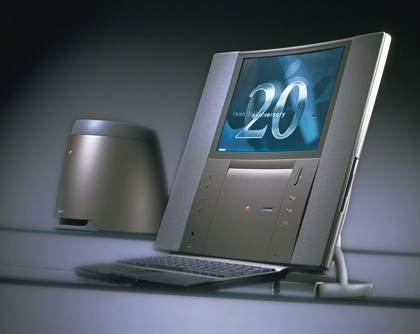6. Motorola ROKR
While the hardware was Motorola, the appeal of the ROKR was all down to Apple. This was the first phone built around syncing to iTunes, and one of the few third-party products to get the full Steve Jobs stage treatment. And… it wasn't good. At all.
Not only was it a tacky product, it was stuffed with infuriating limitations, like only being able to hold 100 songs no matter how much extra storage it was given, offering no way of buying music online and connecting to your Mac or PC via a slow USB 1.1 cable instead of the faster 2.0 standard.
Jobs's demo of the phone conveyed absolutely none of his usual enthusiasm, and for good reason. This was 2005. In 2007, Apple released the iPhone, and the failed first attempt at a Jobs-approved phone was consigned to history.
7. Apple TV
The Jobs seal of approval isn't always a guarantee of quality, then – and Apple TV is another example of a product that failed to make the grade.
Apple TV combined the worst of several worlds – reliance on the Apple ecosystem, lack of an optical drive and the state of internet-available entertainment in the UK back in 2007 – to produce a largely useless electronic paperweight.
Get daily insight, inspiration and deals in your inbox
Sign up for breaking news, reviews, opinion, top tech deals, and more.

In fairness, the Apple TV wasn't a terrible unit, but it hit too early and was too much a company player instead of focusing on what customers would actually be best served by. Nowadays there are so many other options available that the window of opportunity for it has well and truly closed.
Apple still makes the devices, but even it has largely moved on to focusing on new products. Apple TV may have introduced people to the idea of media streaming in their house, but it's products like the WD-TV Live and PlayOn that are finally making the humble computer a fundamental part of the TV watching experience.
8. QuickTake Camera
Much like the Newton, the QuickTake's failure had less to do with the product itself than the situation it found itself in. It was one of the first consumer-level digital cameras, so it was fairly rough and ready – no screen, no easy photo deletion – and it shot at a resolution of 640 x 480, with a pitiful 1MB of memory.
Three different versions were released from 1994 onwards, but like most of Apple's non-computing-focused products, Jobs axed the line after returning to power.
9. The Twentieth Anniversary Mac
$7,499. We shall repeat that: $7,499. No matter how much of an Apple obsessive you might be, no matter how much you think the user interface and style warrants high price tags, dropping $7,499 on a new machine to celebrate a company's milestone is on the wrong side of the Lala River in the valley of Areyoukidding.

This was 1997, when a regular Mac of the same specification would cost you just $3,000. Apple managed to sell a handful at this insane price, but it was quickly forced to back down. By 1998, when the unit was discontinued, the price was down to under $2,000.
It may have looked snazzy next to the resolutely ugly beige boxes of the time, but the Twentieth Anniversary was proof that you can in fact put a price on style, and it's one that most people aren't ultimately that willing to pay. It has become something of a collector's item, however; perhaps that counts as success of a kind.